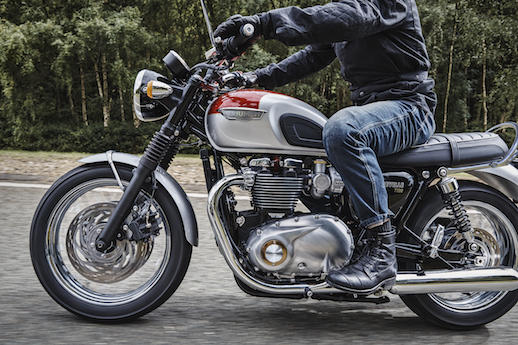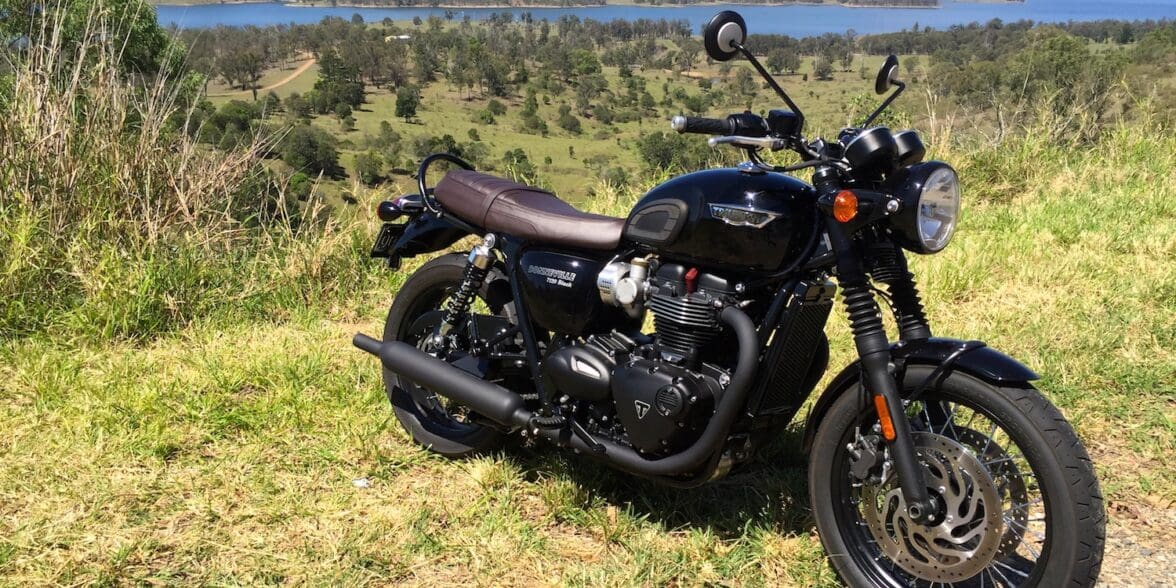The liquid-cooled Triumph T120 is such a quantum leap up from the old air-cooled Bonneville T100 it will even convince the most ardent of traditionalists.
The T120 revives the 1959 name and retains that classic retro vibe, yet the detail, finish, handling, power, torque, comfort, features, safety, economy and overall performance are so much better.
The new T120 and T120 Black cost $17,000 plus on-road costs which is about $3000 more than the old 856cc T100 models and $1500 more than the new 900cc T100. However, I believe the price hike is justified.
Some may prefer the simple, air-cooled bikes with the lumpy 360-degree crank rather than the smoother 270 firing interval. But they will soon be convinced as I was.

As soon as I fired up the engine with the modern one-touch kill/ignition switch I was hooked.
The 1200cc, eight-valve, liquid-cooled, parallel twin engine does not quite sound the same, but the deeper throb from the twin peashooter mufflers is delicious.
The straight-line exhausts have a clever twin-skin design that covers the pipe run through the cat box and out again. It not only looks neat, but sounds terrific.
And once you experience the urge and easy low-to-midrange torque boost of the bigger twin, you will forget any fanciful romantic notions of 360-degree cranks and farting exhausts.
This twin is a thoroughly infectious engine that is quick revving, flexible and lusty.
It is married to a silky smooth six-speed gearbox with taller ratios, so you can spend longer in a gear and enjoy the torque. Yet you can also quickly slip through the gears and enjoy the headiness of the top-end revs.
It hits the soft limiter at 7000 revs, which is 1000 shorter than the previous model. However, with taller gears, it still cruises nicely with sixth gear barely ticking along with 2800rpm at 100km/h. Great for cruising.
Yet the low-to-midrange torque and power are where you will ride most of the time and it’s thrilling and responsive to the fly-by-wire throttle.
Fuelling is smooth and you can easily do feet-up u-turns or small roundabouts without having to slip the clutch.
Perhaps the closest bike to this is the more expensive BMW R nineT ($23,211 ride away) but this drivetrain feels so much more flexible and enjoyable.
It also feels a much lighter and more nimble bike than the Beemer.
It’s 20kg more than the previous model and weighs around the same as the BMW but carries its weight higher. Yet it feels lighter off the side stand and, once mobile, it feels like a much smaller bike.
Thanks to an 18-inch front wheel, down from 19 inches on the T100, it turns quicker and swaps direction very easily. It’s great for a quick succession of corners on your favourite twisty road or threading your way through commuter traffic.
If you start working the gears, it is a rewarding ride and the slip-assist clutch is handy in preventing rear-wheel lock-ups when you are hurrying your downshifts.
It’s not just about go, either. Stopping is now greatly enhanced with twin discs up front and ABS that is effective, smooth and unobtrusive.
The same goes for the switchable traction control which is one of the best I have experienced.
You can turn it on and off easily via a control on the left handlebar that toggles through the vast array of information on the comprehensive twin LCD screens in the dual instrument pods.
I switched traction control off and the massive midrange torque easily induced power slides that came on smoothly.
However, with traction control back on, it allows a little tyre-squirm but with a safety net.
And instead of a sudden loss of power when the traction control comes on, it is hardly noticeable.
In fact, some traction controls cut the power so severely, there is a chance of going from a slide to a high side. Not with this velvet-smooth control.
There are also two engine modes – Road and Rain – available through a control on the right switchblock which softens throttle response for wet roads. Unlike most of these, it doesn’t make the bike feel dead and detached, just more controllable.
Everything about the new T120 exudes sophistication and refinement.
Even the touch of the handlebar controls and switchgear is so much better. The only notchy feel is in the indicator cancel function. Everything else has a luxury car feel.
The level of finish and detail is also luxury class from the classy touches of brass down to the deep and luscious paintwork and chrome. The T120 Black replaces the chrome with a matt finish that won’t shine up with age.
Old T100 riders might love the simplicity of their machines, but I sure would like some of the simple “modern” features added here such as a fuel gauge, gear position indicator and lockable petrol cap.
Other modern creature features include heated grips, engine immobiliser with a transponder in the key fob, convenient USB charging socket near the headstock, LED rear lights and the cool-looking LED daytime running lights which you can use without the headlight.
Riding position is neutral or sit-up-and-beg with a bench seat that is firm, but comfortable with a slight saddle-shaped contour for the rider. Even though it sits 10mm higher, the seat is slimmer, so it should still suit a wide range of rider heights.
On the T120, the saddle is brown which is a nice contrast from all that black.
The pillion gets a seat sash and a nice, thick bar to hold on.
Ride is improved over the T100 thanks to KYB forks and shocks, but I would still consider upgrading the twin shocks if carrying a pillion.
The forks are nicely sorted and don’t have the jackhammer effect of the T100. They also nicely match the rear so the bike doesn’t wallow through bumpy corners.
However, the rear shocks lack some rebound damping, so it does pogo a little on B grade country roads.
The setup provides plenty of confidence for cornering on smooth road surfaces, although you will run out of clearance fairly easily and start scraping the foot pegs.
That’s because the pegs drop down a bit from the mount to give you a more comfortable knee bend. If cornering clearance is more important than comfort, you can swap over for about $90 to the Street Twin pegs which are straight or the Thruxton pegs that step up from the mounts.
Triumph’s choice of Pirelli Phantom tyres is clever as they not only look retro, but also have good all-round capability and high lateral grip.
Even though the tank has dropped 1.5 litres in capacity to 14.5L, the effective range is improved as the fuel economy is so much better.
Despite giving the bike a solid run through the country, up and over hills and not sparing the limiter, it returned 4.3L/100km.
In touring mode, with long stretches in the tall sixth gear, you can expect to see 300km before the fuel light comes on. My T100 fuel light comes on at about 230km.
My only concern is that the engine runs hotter than before, despite being water cooled.
It pumps out a reasonable amount of heat on the right thigh. But being a naked bike, that heat quickly dissipates when you’re moving. It would only be an issue on a slow summer commute.
Like the T100, the new T120 is designed as an all-rounder that has an easy riding position and manoeuvrability for traffic, is competent on a twisting road and is comfortable for midrange touring.
Triumph Bonneville T120 and T120 Black
-
- Price: $17,500
- Engine: 1200cc, liquid-cooled, 8-valve, SOHC, 270° crank angle parallel twin
- Bore x stroke: 97.6 x 80mm
- Compression: 10.0:1
- Power: 59kW @ 6550rpm
- Torque: 105Nm @ 3100rpm
- Transmission: 6-speed; chain drive; wet, multi-plate assist clutch
- Frame: tubular steel cradle
- Wheels: 32-spoke 18 x 2.75in; 17 x 4.25in
- Tyres: 100/90-18; 150/70 R17 Pirelli Phantom
- Suspension: KYB 41mm cartridge forks, 120mm travel; KYB twin shocks with adjustable preload, 120mm rear wheel travel
- Brakes: 310mm discs, Nissin 2-piston floating calipers (front); 255mm disc, Nissin 2-piston floating caliper (rear), ABS
- Instruments: analogue speedometer, analogue tachometer, gear position indicator, fuel gauge, range to empty, service indicator, clock, trip computer, scroll and mode buttons on handlebars, heated grip status, fuel consumption display, traction control status and throttle mode display.
- Width: 785mm
- Height (without mirror): 1125mm
- Seat: 785mm
- Wheelbase: 1445mm
- Rake: 25.5º
- Dry Weight: 224kg
- Tank: 14.5L
- Colours: Cranberry Red and Aluminium Silver, with hand-painted coach lines; Jet Black and Pure White, with hand-painted coach lines; Jet Black; and Cinder Red (T120); Jet Black and Matt Graphite (T120 Black).










